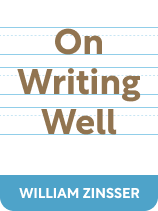

This article is an excerpt from the Shortform book guide to "On Writing Well" by William Zinsser. Shortform has the world's best summaries and analyses of books you should be reading.
Like this article? Sign up for a free trial here .
What is William Zinsser’s book On Writing Well about? How can Zinsser’s tips help you improve your nonfiction writing?
No matter your current skill level, William Zinsser believes anyone can practice the craft of writing. On Writing Well offers a back-to-basics approach, focusing on honing essential writing skills rather than trying to employ complex stylistic techniques.
Here’s a brief overview of the key ideas discussed in On Writing Well: The Classic Guide to Writing Nonfiction by William Zinsser.
On Writing Well: The Classic Guide to Writing Nonfiction
In the book On Writing Well, William Zinsser argues that anyone can learn the craft of writing by practicing the fundamentals of simplicity, clarity, and identity. Zinsser—a writer and professor of creative nonfiction—primarily applies these principles to nonfiction writing, but his ideas extend to other disciplines as well.
Published in 1976, On Writing Well breaks down the principles of good writing and common problems writers encounter in their craft. Zinsser’s advice is helpful for writers of all skill levels, even those who just want to write a better memo or email.
In this guide, we’ll first discuss simplicity and how to achieve it by eliminating clutter and choosing precise words. Then we’ll explore how to achieve clarity through logic and consistency. We’ll also discuss your writing identity and how to make tasteful creative choices. Finally, we’ll discuss common creative nonfiction writing genres.
What Is Simplicity?
Simplicity means your writing is easy to understand because it uses common and precise words as well as simple sentence structures.
(Shortform note: Zinsser’s belief in simple writing may have been influenced by Dr. Rudolf Flesch, who was a popular literacy expert throughout the mid-1900s. He advocated for short and straightforward writing, contending that it improved reading comprehension. His writings on the subject influenced the minimalist writing and editing style of the 20th century. Flesch even created literacy tests to assess the simplicity of a written passage through a combination of word length and sentence length.)
To write simply, follow these guidelines:
Use Common Words
To avoid confusing your reader, write with smaller, more common words. Zinsser believes that a good rule of thumb is to write like you talk since we generally don’t use words with more than three or four syllables. If you wouldn’t say “pulchritudinous” in conversation with a friend, reconsider using it in your writing.
(Shortform note: Some writing experts offer another reason for using common words: People don’t appreciate feeling illiterate. They argue that writers who use complex words appear to be “showing off” and advise writers to get out of this habit. Researchers support this idea, citing overcomplicated writing and flowery language as a common reason manuscripts are rejected.)
Use Precise Words
Simplifying your writing makes your meaning clearer with fewer words. To achieve simplicity, Zinsser advises choosing the best word to suit your meaning and tone. The best word is the one that accurately encapsulates the idea you want to convey. One precise word can do the job of three or four vague words.
Zinsser encourages writers to use a thesaurus and a dictionary when choosing words. Look up synonyms to words in your thesaurus, and use your dictionary to compare the nuances between their meanings. For example, you could describe the sun as “hot,” but also consider writing “boiling” or “scorching.” One word might offer more nuance or meaning than the others, thus making it a better choice.
(Shortform note: While Zinsser encourages both simple and precise word choices, sometimes the most precise word isn’t the simplest or most natural. For example, “susurration” might be more precise, but “murmur” is the simpler choice. Stephen King believes that while an advanced vocabulary can lead to good writing, it isn’t a requirement for it. In your writing, make sure you’re not compromising simplicity by using a more precise—and more complex—word. Instead, find a balance between simplicity and precision, and use words that feel most natural to you.)
Construct Simple Sentences
Zinsser also recommends writing with straightforward sentence structures. A simple sentence structure clearly conveys the subject of the sentence and the action the subject is performing. These sentences are easier for readers to follow than a complex sentence structure with, for example, many clauses or references to different ideas, time periods, events, and so on.
(Shortform note: There may be a scientific reason to use simpler sentence constructions. While researchers don’t know everything about how the human brain understands sentence meaning, some experts believe that we speed up the processing of simple sentences since our brains can more easily predict where the sentence is going.)
Zinsser argues that writing in active voice is the easiest way to construct straightforward sentences. Active voice describes a subject performing an action: For example, “John will drive my car.” This differs from passive voice, which describes an event or action that happens to someone: For example, “My car will be driven by John.” Active voice is simpler, more direct, and less cluttered than passive voice, which is wordy and indirect.
Eliminate Clutter
Zinsser asserts that simple writing can’t have clutter. Clutter is a word or phrase that takes up space but doesn’t add meaning to your sentence. Zinsser believes that it’s your job as a writer to carefully select the right words and delete clutter—this is part of what makes writing a craft. To eliminate clutter from your writing, delete any indirect, wordy, or redundant words and phrases, such as adverbs and euphemisms. Replace these words or phrases with a more succinct term.
(Shortform note: If you’re struggling to delete clutter, try using an online editor like the Hemingway App. This tool highlights hard-to-read sentences, adverbs, passive voice, and other ways your writing may sound confusing. It also lets you evaluate your writing and make thoughtful changes. But be careful not to rely exclusively on these kinds of tools—they shouldn’t be a crutch. Rather, they should help you develop a keener eye for words that aren’t doing necessary work.)
Embrace Rewriting
While you should strive to write with simplicity, don’t expect your first draft to be perfect—there will be clutter and imprecise words in your draft. To achieve simplicity, Zinsser recommends embracing rewriting, or the act of improving what you’ve already written. By rewriting, you’ll find better, simplified ways of expressing your ideas.
Zinsser explains that to rewrite, use your first draft as a guide, and restructure confusing sentences. Delete clutter, and rephrase words or sentences that could be more succinct.
Additionally, test the simplicity of your writing by reading your work out loud. Reading your writing out loud will indicate which sentences need reworking. If you trip over words or phrases, it’s a sign to rewrite it more simply.
What Is Clarity?
Once you’ve achieved simplicity in wording and structuring your sentences, focus on bringing clarity to your writing. Clarity occurs when you logically explain your idea to a reader. Zinsser believes that it’s your job as a writer to guide the reader through your thought process rather than forcing them to dissect disorganized or underdeveloped writing.
Zinsser believes that to write clearly, you must clearly understand the topic you’re writing about. If you don’t understand the topic, you’ll never be able to explain it well to your reader.
Follow a Logical Sequence
To write with clarity, follow a logical sequence of ideas. Each sentence should build off of the idea in the previous sentence. To lead your reader to your next thought, Zinsser recommends anticipating what the reader will ask and answering their question in the next sentence. Constantly ask yourself, “What is the next thing the reader needs to know?” Then answer that question in the next sentence rather than repeating the previous sentence in a different way.
(Shortform note: Truly logical writing answers a reader’s questions before they have a chance to ask them. To make your writing more logical, experts recommend this general formula: state each idea, provide evidence for that idea, and draw a clear connection to the conclusion. This formula works for any kind of argument or proposal. But the formula can also be applied to creative nonfiction like memoirs or travel writing. Your evidence will probably come in the form of the detail you give the reader to back up your claims. For example, instead of just stating someone’s name and occupation, you could describe their uniform. This description would provide evidence to support the idea of their occupation.)
Be Consistent
Consistency, or what Zinsser calls unity, is when certain key elements of your writing stay the same throughout your writing, even as your idea develops. Zinsser believes consistency eliminates unwanted confusion because your reader won’t have to keep up with unnecessary changes in your writing. Keep these three elements consistent throughout your writing:
- Main idea: Your main idea is the most important takeaway from a piece—it’s your whole reason for writing that specific story. Zinsser explains that your main idea will guide your writing and prevent unrelated tangents.
- Point of view: Your point of view is how you narrate your piece. Your point of view establishes a relationship with the reader since it’s how you’ll refer to yourself throughout the story.
- Tense: Tense refers to whether you’re telling your story from the past, present, or future. Zinsser notes that tenses help your reader situate themselves in the timeline of events.
- Tone: Zinsser explains that tone signals what you think or how you feel about your topic. For example, you could take a lighthearted, nostalgic, or formal tone toward your writing.
Zinsser explains that while you can take some artistic liberty with your writing, you have to stick with whatever decisions you make. As you write, you can change your mind, but make sure that change is reflected throughout the rest of your writing. For example, you may start writing a piece in third person, only to decide midway through that you think first person would work better. It’s okay to change your mind, but be sure to go back and change the parts you’ve already written in third person to first person.
(Shortform note: Zinsser points out the importance of consistency with big decisions like tone, main idea, tense, and point of view. But it’s also important to be consistent for small decisions like punctuation and spelling. To ensure consistency in writing, some publications and businesses adhere to a style guide. Some of the more common style guides are AP style, Chicago style, APA style, and MLA style. You can use these guides as a reference to answer certain consistency questions about spelling, word hyphenation, punctuation, and more.)
What Is Identity?
Zinsser’s third principle of good writing is identity, or what makes your writing unique to you. It’s the specific style and personality that you as an individual bring to your writing. Zinsser explains that identity is a writer’s most recognizable quality to a reader. If a reader likes your identity and the way you tell stories, they’ll read more of your writing because they’re interested in what you have to say and how you say it. Zinsser argues that identity will determine whether or not readers like you as a writer.
Identity also differentiates your writing from other writers. Due to identity, two writers can tell the same story in two completely different ways. While one way isn’t superior to the other, a reader will have a preference for one style over the other. Having a recognizable writing identity influences whether or not a reader chooses to read your work when they could read someone else’s.
Zinsser believes identity is your personality and style revealing itself through words. While writing like yourself should eventually feel effortless, Zinsser offers these tips for finding your writing identity:
Write for Yourself
To write in your unique style, start by writing for yourself. Zinsser explains that your identity will shine through when you write about things that you want to write about. Or ask yourself what you want to read, and write about that. By letting your interests direct your writing topic, you’ll be more passionate when writing about it.
(Shortform note: In On Writing, Stephen King offers a different perspective, suggesting that you keep one reader in mind as you write: your Ideal Reader. Your Ideal Reader is usually the one person whose opinion you trust above all. You come to know your Ideal Reader’s tastes so well you can predict how he or she will feel about any particular thing you’re writing. The Ideal Reader helps give you an audience as you write rather than writing strictly for yourself, as Zinsser recommends. The Ideal Reader should also be an honest reviewer—supportive but unrelenting. You might disagree with Ideal Reader’s feedback, but you know there’s truth to it.)
Write in First Person
Once you find a topic you’re passionate about, write about it from your own perspective, or in first person. Zinsser explains that since we generally speak in first person, writing with “I” should feel natural. Avoid trying to tell a story through someone else’s eyes because it will place a barrier between your thoughts and your natural writing voice.
(Shortform note: If you’re still struggling to connect to your writing or topic, try practicing your skills of observation and reflection through “wakewalking” (as opposed to sleepwalking), which is a kind of meditation for writers. To wakewalk, take a walk outside and name things you see, such as a tree, rock, or stream. Then describe one of these things using all five of your senses. As you interact with the object, write down your internal feelings about it. It might stir up an old emotion or memory, or you might find a new way to describe it. By wakewalking, you can practice relating to the world and writing about the connections you make.)
Write Like Yourself All the Time
Zinsser advises against changing your voice from piece to piece. Writing in your own voice will help you develop your identity since you’ll be consistently practicing writing in your unique voice. Eventually, your voice will come to you immediately and naturally when you write. Readers will also recognize you by your writing identity.
(Shortform note: Many bloggers’ success stems from developing a signature writing voice that readers instantly recognize. For example, readers recognize Mark Manson for his unashamed use of curse words, his storytelling, and his way of writing to the reader like a friend. Manson’s blog quickly gained a large following, so when he published The Subtle Art of Not Giving a F*ck, he already had a dedicated audience who was interested in his writing style and what he had to say.)
Write Like Your Favorite Writers
Zinsser recommends reading writers with great taste to study what those creative decisions look like. Then write as they write. They’re your favorite writers for good reason, so take the time to mirror their techniques and find what works for you. Don’t be afraid of copying them—Zinsser believes you’ll eventually graduate into your own unique voice.
(Shortform note: In Steal Like an Artist, Austin Kleon echoes Zinsser’s advice to take inspiration from great art and artists in any medium—doing so will help you create better art. Kleon recommends studying one artist, her work, and what you like about her work. Kleon believes that by copying your mentor’s work and creative process, you’ll create something new. The ways in which you’re different from your creative mentor will reveal your unique strengths and develop your taste. You’ll inevitably fail to create a perfect copy of your mentor’s work since it’s personal to her and her tastes—just as your work will be personal to you.)
Creative Nonfiction
Zinsser focuses on improving the craft of writing—specifically, nonfiction writing. To write better nonfiction, first dispel the myth that nonfiction is boring. Some people have the misconception that nonfiction writing is uncreative, especially when compared to fiction. But Zinsser contends that this isn’t true. Nonfiction writing allows us to creatively explore the truth of everyday life and the experience of being human.
The benefit to writing nonfiction is that you have many people, places, and lives to draw inspiration from without the pressure of creating fictional characters, places, or events. Zinsser encourages writers to be interested in new ideas and experiences because these will give you more engaging topics to write about.
(Shortform note: Experts expand on Zinsser’s idea that nonfiction can be as creative and engaging as fiction, contending that the line between fiction and nonfiction can be a blurry one. There are many fictional stories based heavily on real events, and there are many nonfiction stories that take liberties with the definition of “truth.” For example, The Things They Carried by Tim O’Brien discusses the narrator’s (whose name is also Tim O’Brien) experience in the Vietnam War—yet the book is classified as historical fiction. Thus one main difference between the genres is whether the writer categorizes the work as fiction or nonfiction, thus drawing their own line between fiction and nonfiction.)
By writing simply, clearly, and in your own voice, you’ll have the skills to write in any genre. But writing engaging nonfiction also has its challenges. Zinsser discusses eight specific genres of nonfiction and common problems writers face when writing in these genres.
Interviews
Zinsser encourages writers to include interviews incorporating direct quotes and information from another person into their pieces. By including someone else’s perspective in their own words—not yours—your writing will have more humanity and be more engaging.
(Shortform note: Other experts also encourage the use of interviews, noting that they can engage your reader through pathos—an emotional appeal to your audience. By discussing a topic with someone who knows about it or is directly affected by it, you’ll connect with your reader. For example, a news story about a flood will be more engaging if the journalist includes an interview with a family whose home was destroyed by the flood than if the journalist just gave the statistics about the flood damage.)
Humor
Humor is a writing form that uses a lighthearted or funny approach to reveal absurd or harsh truths about humanity. Zinsser believes sometimes not being “serious” is the best and only way to talk about serious topics, like war, famine, violence, and so on.
(Shortform note: If you’re struggling to write humor, first try identifying your own sense of humor. What do you find funny? One-liners? Wit? Sarcasm? Dark humor? Anecdotes? Self-deprecation? Read different types of humor to identify your style. Once you’ve identified your humor, try drawing from your personal experience for inspiration. What kind of funny anecdotes could you write about?)
Travel
Travel writing describes a place, the people who live there, and what it’s like to be there. These features should reveal a deeper truth about the city or its people. What’s special about this place and its people?
(Shortform note: When thinking about Zinsser’s idea of travel writing as understanding the humanity of a place and its people, consider Erich Fromm’s distinction between looking and seeing to improve your ability to find and write deeper truths about a place and its people. He relates looking to an interest in lifeless, immobile artifacts. But unlike simply looking at something, seeing implies a recognition of the life or humanity in something. Seeing requires embracing your own humanity, openness, and interest in the world. So rather than trying to use your writing as a form of looking, write with the intent to see the life of a place and its people.)
Sports
Sportswriting is a form of nonfiction that reports on topics involving sports, such as athletes, games, and competitions. Zinsser notes that sportswriters often make themselves and their knowledge the focus rather than the athlete or the game. Tell the story through your perspective, but don’t tell a story about yourself. For example, you can report on a professional basketball game without describing your personal history of playing basketball in grade school.
(Shortform note: To focus and improve your sportswriting, identify the key components of any sports story: the highlights of the game, the team names, the score, and when and where the game took place. Make these elements the most important part of the story—details and your own commentary should only support these main elements.)
Criticisms
Zinsser explains that criticisms are another popular form of nonfiction, where an author reviews the artistic merit of a creative work. This work can be in any medium, such as visual art, literature, cinema, and so on. He believes that the writer should appreciate and be familiar with the medium as a whole since criticisms situate the work into the broader context of other similar works.
(Shortform note: Zinsser focuses on using criticisms to situate readers into the broader context of a genre. But in How to Read a Book, Mortimer J. Adler and Charles van Doren explain that criticizing a book means to comment, “I agree,” “I disagree,” or “I suspend judgment.” Their views can also be adapted for other media. When you’re criticizing an author, Adler and Van Doren caution against being overly contentious or combative. A discussion isn’t something to be won: It’s an opportunity to discover the truth. Remember that disagreement is an opportunity to learn something new.)
Memoir
In a memoir, a writer describes a specific event or point in time that he experienced. Zinsser explains that unlike an autobiography—which discusses the writer’s life story—a memoir has a narrow focus. If you want to write a memoir, Zinsser recommends picking a specific idea, moment, or theme from your personal experience. Then write about that instance in depth, conveying the importance of that idea to you and your life. The more detailed you can be, the better. Details will paint a more complete picture of this idea or moment.
(Shortform note: Unlike Zinsser, other writers caution against sharing some personal stories. Experts cite a culture of oversharing, spurred largely by the internet and social media, as a reason for the popularization of the memoir. There may also be a biological reason for telling personal stories: A Harvard study found that the brain’s neurochemical reward system is activated more when we share personal thoughts and less when we report on the opinions of others. Before you publish your story, ask yourself if your memoir borders the line of oversharing personal information.)
Science and Technology
Science and technology writing is a nonfiction genre that centers on technical subjects. Zinsser argues that science and technical writers often lack humanity in their pieces, resulting in an overly-logical and impersonal article. To avoid this, write like yourself, not a robot. Imagine how you’d explain this subject to a friend or family member in a casual conversation, then translate that onto paper.
(Shortform note: To incorporate humanity into science and technology writing, tell a story about real people. Many science writers think that explaining the widespread effects of an issue will persuade their audience of an issue’s importance. But this approach relies on the abstract principles of the problem. Instead, be specific by discussing a real person or group and how this research affects them. Your reader can relate to this person and understand the effects through this lens.)
Business
In most companies, employees use some form of written communication, such as emails, memos, copywriting, newsletters, or social media captions. All of these different forms are types of business writing. Zinsser recommends that you make your business writing sound personal. He believes a reader wants to know that she’s reading the words of a person, not a business. Organizations don’t write emails or memos—people do. (Shortform note: Companies have embraced Zinsser’s version of personal business writing and are now creating consistent brand voices, or the unique personality of their communications with consumers. One key element of a brand voice is identifying what kind of person your business would be and using that type of person to communicate with customers. For example, Nike’s brand voice persona is an athlete who uses strong, inspiring language to motivate consumers.)

———End of Preview———
Like what you just read? Read the rest of the world's best book summary and analysis of William Zinsser's "On Writing Well" at Shortform .
Here's what you'll find in our full On Writing Well summary :
- A back-to-basics approach to the craft of writing
- How to practice simple, clear, and engaging writing—even if you're not a writer
- How to effectively put your ideas into words






